Onkyo DX-R700 User Manual
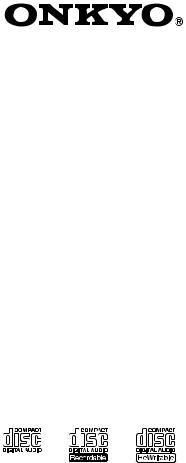
Audio CD Recorder
DX-R700
Instruction
Manual
Thank you for purchasing the Onkyo Audio CD Recorder. Please read this manual thoroughly before making connections and plugging in the unit. Following the instructions in this manual will enable you to obtain optimum performance and listening enjoyment from your new Audio CD Recorder. Please retain this manual for future reference.
Contents
Before using |
2 |
|
|
|
|
Connections |
14 |
|
|
|
|
Operations |
16 |
|
|
|
|
Other Information |
42 |
|
|
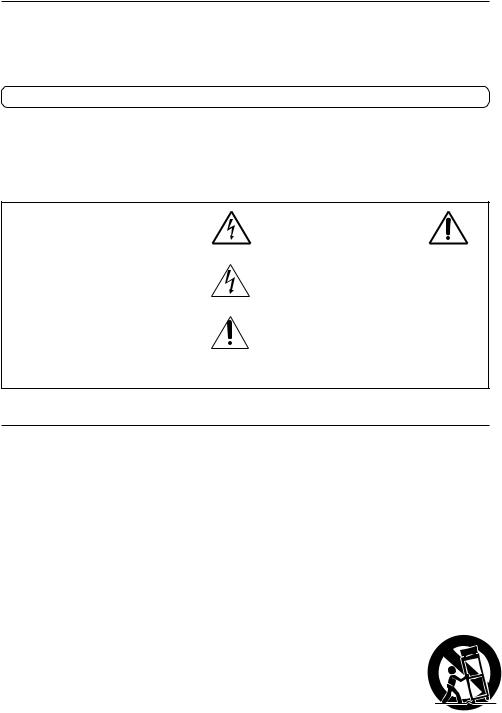
Before using
Thank you for purchasing ...
Thank you for purchasing the Onkyo DX-R700 CD Recorder.
Please read this manual thoroughly before making connections and plugging in the unit.
Following the instructions in this manual will enable you to obtain the optimum performance and listening enjoyment from your new DX-R700.
Please retain this manual for future reference.
Main Features
• |
CD/CD-R/CD-RW Disc Compatibility |
• Adjustable Recording Volume |
• |
Auto Finalizing Function |
(Digital/Analog) |
• |
32kHz/44.1kHz/48kHz Sampling-Rate Converter |
• High-Resolution D/A & A/D Converter |
• 1 Optical/1 Coaxial Digital Inputs |
• 1 Optical/1 Coaxial Digital Outputs |
|
• |
Signal Synchro Recording |
• zCable Included |
•Name input function allowing you to specify a disc name, track titles, and an artist name.
WARNING:
TO REDUCE THE RISK OF FIRE OR ELECTRIC SHOCK, DO NOT EXPOSE THIS APPLIANCE TO RAIN OR MOISTURE.
CAUTION:
TO REDUCE THE RISK OF ELECTRIC SHOCK, DO NOT REMOVE COVER (OR BACK). NO USER-SERVICEABLE PARTS INSIDE. REFER SERVICING TO QUALIFIED SERVICE PERSONNEL.
WARNING |
|
AVIS |
RISK OF ELECTRIC SHOCK |
|
RISQUE DE CHOC ELECTRIQUE |
DO NOT OPEN |
|
NE PAS OUVRIR |
|
|
|
The lightning flash with arrowhead symbol, within an equilateral triangle, is intended to alert the user to the presence of uninsulated “dangerous voltage” within the product’s enclosure that may be of sufficient magnitude to constitute a risk of electric shock to persons.
The exclamation point within an equilateral triangle is intended to alert the user to the presence of important operating and maintenance (servicing) instructions in the literature accompanying the appliance.
Important Safeguards
1.Read Instructions – All the safety and operating instructions should be read before the appliance is operated.
2.Retain Instructions – The safety and operating instructions should be retained for future reference.
3.Heed Warnings – All warnings on the appliance and in the operating instructions should be adhered to.
4.Follow Instructions – All operating and use instructions should be followed.
5.Cleaning – Unplug the appliance from the wall outlet before cleaning. The appliance should be cleaned only as recommended by the manufacturer.
6.Attachments – Do not use attachments not recommended by the appliance manufacturer as they may cause hazards.
7.Water and Moisture– Do not use the
appliance near water –for example, near a bath tub, wash bowl, kitchen sink, or laundry tub; in a wet basement; or near a swimming pool; and the like.
8.Accessories – Do not place the appliance on an unstable cart, stand, tripod, bracket, or table. The appliance may fall, causing serious injury to a child or adult, and serious damage to the appliance. Use only with a cart, stand, tripod, bracket, or table recommended by the manufacturer, or sold with the appliance. Any mounting of the appliance should follow the manufacturer’s instructions, and should use a mounting accessory
r e c o m m e n d e d b y t h e manufacturer.
9. An appliance and cart combination should be moved with care. Quick stops, excessive force, and
S3125A
2

Important Safeguards
uneven surfaces may cause the appliance and cart combination to overturn.
10.Ventilation – Slots and openings in the cabinet are provided for ventilation and to ensure reliable operation of the appliance and to protect it from overheating, and these openings must not be blocked or covered. The openings should never be blocked by placing the appliance on a bed, sofa, rug, or other similar surface. The appliance should not be placed in a builtin installation such as a bookcase or rack unless proper ventilation is provided. There should be free space of at least 5 cm (2 in.) and an opening behind the appliance.
11.Power Sources – The appliance should be operated only from the type of power source indicated on the marking label. If you are not sure of the type of power supply to your home, consult your appliance dealer or local power company.
12.Grounding or Polarization – The appliance may be equipped with a polarized alternating current line plug (a plug having one blade wider than the other). This plug will fit into the power outlet only one way. This is a safety feature. If you are unable to insert the plug fully into the outlet, try reversing the plug. If the plug should still fail to fit, contact your electrician to replace your obsolete outlet. Do not defeat the safety purpose of the polarized plug.
13.Power-Cord Protection – Powersupply cords should be routed so that they are not likely to be walked on or pinched by items placed upon or against them, paying particular attention to cords at plugs, convenience receptacles, and the point where they exit from the appliance.
14.Lightning – For added protection for the appliance during a lightning storm, or when it is left unattended and unused for long periods of time, unplug it from the wall outlet and disconnect the antenna or cable system. This will prevent damage to the appliance due to lightning and power-line surges.
15.Overloading – Do not overload wall outlets, extension cords, or integral convenience receptacles as this can result in a risk of fire or electric shock.
16.Object and Liquid Entry – Never push
objects of any kind into the appliance through openings as they may touch dangerous voltage points or short-out parts that could result in a fire or electric shock. Never spill liquid of any kind on the appliance.
17.Servicing – Do not attempt to service the appliance yourself as opening or removing covers may expose you to dangerous voltage or other hazards. Refer all servicing to qualified service personnel.
18.Damage Requiring Service – Unplug the appliance form the wall outlet and refer servicing to qualified service personnel under the following conditions:
A.When the power-supply cord or plug is damaged,
B.If liquid has been spilled, or objects have fallen into the appliance,
C.If the appliance has been exposed to rain or water,
D.If the appliance does not operate normally by following the operating instructions. Adjust only those controls that are covered by the operating instructions as an improper adjustment of other controls may result in damage and will often require extensive work by a qualified technician to restore the appliance to its normal operation,
E.If the appliance has been dropped or damaged in any way, and
F.When the appliance exhibits a distinct change in performance – this indicates a need for service.
19.Replacement Parts – When replacement parts are required, be sure the service technician has used replacement parts specified by the manufacturer or have the same characteristics as the original part. Unauthorized substitutions may result in fire, electric shock, or other hazards.
20.Safety Check – Upon completion of any service or repairs to the appliance, ask the service technician to perform safety checks to determine that the appliance is in proper operation condition.
21.Wall or Ceiling Mounting – The appliance should be mounted to a wall or ceiling only as recommended by the manufacturer.
22.Heat – The appliance should be situated away from heat sources such as radiators, heat registers, stoves, or other appliances (including amplifiers) that produce heat.
3
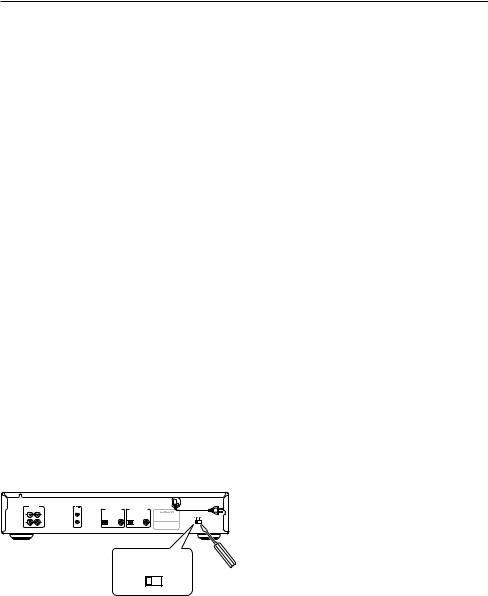
Precautions
1. Warranty Claim
You can find the serial number on the rear panel of this unit. In case of warranty claim, please report this number.
2. Recording Copyright
Recording of copyrighted material for other than personal use is illegal without permission of the copyright holder.
3. Power
WARNING
BEFORE PLUGGING IN THE UNIT FOR THE FIRST TIME, READ THE FOLLOWING SECTION CAREFULLY.
The voltage of the available power supply differs according to country or region. Be sure that the power supply voltage of the area where this unit will be used meets the required voltage (e.g., AC 230 V, 50 Hz or AC 120 V, 60 Hz) written on the rear panel.
Worldwide models are equipped with a voltage selector to conform with local power supplies. Be sure to set this switch to match the voltage of the power supply in your area before plugging in the unit.
Determine the proper voltage for your area: 220230 V or 120 V.
If the preset voltage is not correct for your area, insert a screwdriver into the groove in the switch. Slide the switch all the way to the upper (120 V) or to the lower (220-230 V), whichever is appropriate.
ANALOG |
|
|
|
|
|
|
|
|
|
INPUT |
OUTPUT |
REMOTE |
DIGITAL INPUT |
DIGITAL OUTPUT |
|
|
|
||
(REC) |
(PLAY) |
CONTROL |
1 |
2 |
|
|
|
|
|
L |
|
L |
OPTICAL |
COAXIAL |
OPTICAL |
COAXIAL |
AUDIO CD RECORDER |
VOLTAGE SELECTOR |
|
|
|
|
|
|
|
|
MODEL NO. DX-R700 |
220-230V |
120V |
R |
|
R |
|
|
|
|
|
|
|
VOLTAGE SELECTOR
220-230V

 120V
120V 
4. Do not touch this unit with wet hands
Do not handle this unit or power cord when your hands are wet or damp. If water or any other liquid enters the case, take this unit to an authorized service center for inspection.
5. Location of this unit
Place this unit in a well-ventilated location.
Take special care to provide plenty of ventilation on all sides of this unit especially when it is placed in an audio rack. If ventilation is blocked, this unit may overheat and malfunction.
Do not expose this unit to direct sunlight or heating units as this unit’s internal temperature may rise and shorten the life of the pickup.
Avoid damp and dusty places and places directly affected by vibrations from the speakers. In particular, avoid placing the unit on or above one of the speakers.
Be sure this unit is placed in a horizontal position. Never place it on its side or on a slanted surface as it may malfunction.
Do not place near tuners or TV sets.
If placed next to a TV or tuner, it may cause reception interference resulting in some noise in the TV or tuner output.
6. Care
From time to time you should wipe the front and rear panels and the cabinet with a soft cloth. For heavier dirt, dampen a soft cloth in a weak solution of mild detergent and water, wring it out dry, and wipe off the dirt. Following this, dry immediately with a clean cloth.
Do not use rough material, thinners, alcohol or other chemical solvents or cloths since these could damage the finish or remove the panel lettering.
7. Points to remember
If this unit is brought from a cold environment to a warm one or is in a cold room that is quickly heated, condensation may form on the pickup, preventing proper operation. In this case, remove the disc and leave the power ON for about one hour to remove the condensation.
When transporting this unit, be careful not to bump it.
4

Precautions
DANGER:
INVISIBLE LASER RADIATION WHEN OPEN AND INTERLOCK FAILED OR DEFEATED. AVOID DIRECT EXPOSURE TO BEAM.
CAUTION:
THIS PRODUCT UTILIZES A LASER. USE OF CONTROLS OR ADJUSTMENTS OR PERFORMANCE OF PROCEDURES OTHER THAN THOSE SPECIFIED HEREIN MAY RESULT IN HAZARDOUS RADIATION EXPOSURE.
For U.S. model
The laser is covered by a housing which prevents exposure during operation or maintenance. However, this product is classified as a Laser Product by CDRH (Center for Devices and Radiological Health) which is a department of the Food and Drug Administration. According to their regulations 21 CFR section 1002.30, all manufactures who sell Laser Products must maintain records of written communications between the manufacturer, dealers and customers concerning radiation safety. If you have any complaints about instructions or explanations affecting the use of this product, please feel free to write to the address on the back page of this manual. When you write us, please include the model number and serial number of your unit.
In compliance with Federal Regulations, the certification, identification and the period of manufacture are indicated on the rear panel.
FCC INFORMATION FOR USER
CAUTION:
The user changes or modifications not expressly approved by the party responsible for compliance could void the user’s authority to operate the equipment.
NOTE:
This equipment has been tested and found to comply with the limits for a Class B digital device, pursuant to Part 15 of the FCC Rules. These limits are designed to provide reasonable protection against harmful interference in a residential installation. This equipment generates, uses and can radiate radio frequency energy and, if not installed and
used in accordance with the instructions, may cause harmful interference to radio communications. However, there is no guarantee that interference will not occur in a particular installation. If this equipment does cause harmful interference to radio or television reception, which can be determined by turning the equipment off and on, the user is encouraged to try to correct the interference by one or more of the following measures:
•Reorient or relocate the receiving antenna.
•Increase the separation between the equipment and receiver.
•Connect the equipment into an outlet on a circuit different from that to which the receiver is connected.
•Consult the dealer or an experienced radio/TV technician for help.
Declaration of Conformity
We, ONKYO EUROPE ELECTRONICS GmbH INDUSTRIESTRASSE 20 82110 GERMERING, GERMANY
declare in own responsibility, that the ONKYO product described in this instruction manual is in compliance with the corresponding technical standards such as EN60065, EN55013, EN55020 and EN61000-3-2, -3-3 
GERMERING, GERMANY
A.HORIUCHI
ONKYO EUROPE ELECTRONICS GmbH
Memory Preservation
This unit does not require memory preservation batteries. A built-in memory power back-up system preserves the contents of the memory during power failures and even when the unit is unplugged. The unit must be plugged-in in order to charge the back-up system.
The memory preservation period after the unit has been unplugged varies depending on climate and placement of the unit. On the average, memory contents are protected over a period of a few weeks after the last time the unit was unplugged. This period is shorter when the unit is exposed to a highly humid climate.
5

Precautions
For Canadian model
NOTE: THIS CLASS B DIGITAL APPARATUS COMPLIES WITH CANADIAN ICES-003.
For models having a power cord with a polarized plug:
CAUTION: TO PREVENT ELECTRIC SHOCK, MATCH WIDE BLADE OF PLUG TO WIDE SLOT, FULLY INSERT.
Modele pour les Canadien
REMARQUE: CET APPAREIL NUMÉRIQUE DE LA CLASSE B EST CONFORME À LA NORME NMB-003 DU CANADA.
Sur les modèles dont la fiche est polarisée: ATTENTION: POUR ÉVITER LES CHOCS ÉLECTRIQUES, INTRODUIRE LA LAME LA PLUS LARGE DE LA FICHE DANS LA BORNE CORRESPONDANTE DE LA PRISE ET POUSSER JUSQU’AU FOND.
For European model
This unit contains a semiconductor laser system and is classified as a “CLASS 1 LASER PRODUCT.” So, to use this model properly, read this Instruction Manual carefully. In case of any trouble, please contact the store where you purchased the unit. To prevent being exposed to the laser beam, do not try to open the enclosure.
“CLASS 1 LASER
PRODUCT”
This label on the left hand panel states that:
1.This unit is a CLASS 1 LASER PRODUCT and employs a laser inside the cabinet.
2.To prevent the laser from being exposed, do not remove the cover. Refer servicing to qualified personnel.
For British model
Replacement and mounting of an AC plug on the power supply cord of this unit should be performed only by qualified service personnel.
IMPORTANT
The wires in the mains lead are coloured in accordance with the following code:
Blue : Neutral Brown : Live
As the colours of the wires in the mains lead of this apparatus may not correspond with the coloured markings identifying the terminals in your plug, proceed as follows:
The wire which is coloured blue must be connected to the terminal which is marked with the letter N or coloured black.
The wire which is coloured brown must be connected to the terminal which is marked with the letter L or coloured red.
IMPORTANT
A 5 ampere fuse is fitted in this plug. Should the fuse need to be replaced, please ensure that the replacement fuse has a rating of 5 amperes and that it is approved by ASTA or BSI to BS1362. Check for the ASTA mark or the BSI mark on the body of the fuse.
IF THE FITTED MOULDED PLUG IS UNSUITABLE FOR THE SOCKET OUTLET IN YOUR HOME, THEN THE FUSE SHOULD BE REMOVED AND THE PLUG CUT OFF AND DISPOSED OF SAFELY. THERE IS A DANGER OF SEVERE ELECTRICAL SHOCK IF THE CUT OFF PLUG IS INSERTED INTO ANY 13 AMPERE SOCKET.
If in any doubt, please consult a qualified electrician.
6

Table of contents |
|
Before Using |
|
Thank you for purchasing ... ............................................................... |
2 |
Important Safeguards ......................................................................... |
2 |
Precautions ........................................................................................ |
4 |
Table of contents ................................................................................ |
7 |
Supplied accessories ........................................................................... |
7 |
Part names and functions ................................................................... |
8 |
Using the remote controller .............................................................. |
11 |
Notes on usable CDs ........................................................................ |
12 |
Connections |
|
Connecting the DX-R700 ................................................................. |
14 |
Operations |
|
Turning on the power ...................................................................... |
16 |
Inserting a disc ................................................................................. |
17 |
Recording modes ............................................................................. |
18 |
Digital recording/Analog recording ................................................... |
20 |
Synchronous recording by input digital signal detection .................... |
22 |
Synchronous recording ..................................................................... |
24 |
Using the level sync function ............................................................ |
26 |
Changing the display ....................................................................... |
27 |
Entering names ................................................................................ |
28 |
Finalization ....................................................................................... |
33 |
Erasing recordings (CD-RW discs only) .............................................. |
34 |
Playing CDs ...................................................................................... |
38 |
Other Information |
|
Rules concerning digital recording .................................................... |
42 |
Display messages ............................................................................. |
42 |
Troubleshooting guide ..................................................................... |
43 |
Specifications ................................................................................... |
46 |
Supplied accessories
Check that the following accessories are supplied with the DX-R700.
•Audio connection cables × 2
•Remote controller × 1
1 |
|
4 |
|
7 |
2 |
5 |
3 |
8 |
6 |
|
9 |
R
E
M
O
T
E
C
O
N
T
R
O
LLE
R
R C- 448 C
• Optical digital cable × 1 |
• zcable × 1 |
•Dry-cell batteries
(size AA, R06, or UM-3) × 2
7

Part names and functions
1 |
2 |
3 |
|
4 |
|
5 |
|
|
6 |
7 |
8 |
|
9 |
|
|
|
|
|
|
DUAL DIGITAL INPUT |
|
|
|
|
|
|
|
|
STANDBY/ON |
|
|
|
|
|
|
|
|
PAUSE |
STOP |
|
PLAY |
|
|
MEMORY |
CLEAR |
|
|
DISPLAY |
MULTI JOG |
INPUT |
|
|
|
|
|
|
STANDBY |
|
|
|
|
|
|
|
|
|
PHONES |
PHONES LEVEL |
|
|
POWER |
|
REPEAT |
FINALIZE |
|
|
EDIT/ NO |
|
YES |
REC |
|
|
|
|
|
|
|
|
|
|
|
PUSH TO ENTER |
|
|
|
|
|
|
|
|
|
|
|
|
|
|
|
|
|
MIN |
MAX |
|
ON OFF |
|
|
|
|
|
|
|
|
|
AUDIO CD RECORDER DX-R700 |
||
|
|
|
|
|
|
|
|
|
|
|
|||
|
|
22 |
21 |
20 |
19 |
18 17 16 |
15 14 13 12 |
11 |
10 |
||||
A C
B |
D |
|
M |
||
E |
||
|
L K J I H G F
ANALOG |
|
|
|
|
|
|
|
|
|
INPUT |
OUTPUT |
REMOTE |
DIGITAL INPUT |
DIGITAL OUTPUT |
|
|
|
||
(REC) |
(PLAY) |
CONTROL |
1 |
2 |
|
|
|
|
|
L |
|
L |
OPTICAL |
COAXIAL |
OPTICAL |
COAXIAL |
AUDIO CD RECORDER |
VOLTAGE SELECTOR |
|
|
|
|
|
|
|
|
MODEL NO. DX-R700 |
220-230V |
120V |
R |
|
R |
|
|
|
|
|
|
|
23 |
24 |
25 |
26 |
27 |
28 |
8
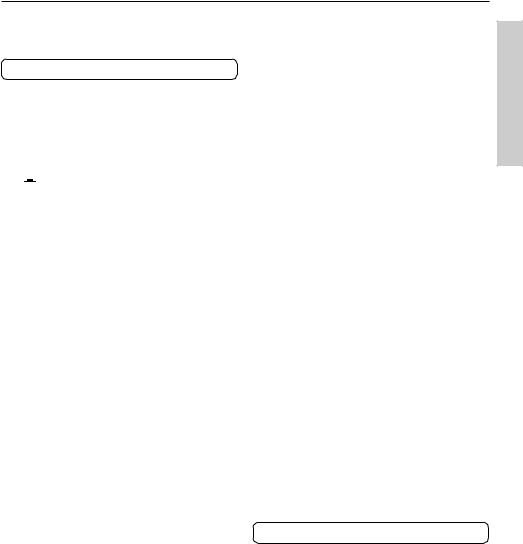
Part names and functions
The numbers within the brackets are the pages where the part is introduced.
Front panel
1POWER switch (POWER ON/
ON/ OFF) [16]
OFF) [16]
Press in to turn on the main power.
2STANDBY/ON button and STANDBY
indicator [16]
Press to turn the DX-R700 on or to put it in standby state while the main power is on
( ON). When the DX-R700 enters the standby state, the STANDBY indicator lights.
3MEMORY (programmed playback) button [40]
Press to program the tracks to play in memory.
4CLEAR button [40]
Press to erase the programmed tracks one at a time from the end. This button is also used to erase the character entered.
5Disc tray [17]
6r(tray open/close) button [17]
Press to open and close the disc tray.
7gPAUSE button [38]
Press during playback to pause the playback. Press the sbutton to resume playback.
8eSTOP button [38]
Press to stop recording or playback.
9sPLAY button [38]
Press to start analog recording, digital recording, and playback.
10PHONES LEVEL dial [41]
Adjusts the output level for the PHONES jack.
11PHONES jack [41]
Connects stereo headphones with a standard stereo plug.
12d/f(rewind/fast forward) buttons
[38]
Press to rewind or fast forward through the track currently playing.
13oREC (recording) button [20, 22, 25]
For analog and digital recording, press to place the DX-R700 in the recording standby state.
14INPUT button [20, 22, 24]
Press to select the input source.
15YES button [31-33]
Press to confirm displayed settings during entering names, finalizing, and other operations.
16qMULTI JOG wdial [21, 26, 28-32, 34-38]
Use to jump to tracks prior to or later than the one currently playing. Use while playback is stopped to select the track to play.
17EDIT/NO button [21, 26, 28, 31, 32, 34-37]
Press to display the operations for erasing, name input, and other operations. To select a displayed operation, turn the MULTI JOG dial.
18DISPLAY button [27-29]
Press to change the contents of the display.
19Front display
A NAME indicator
B DISC/TRACK/ARTIST indicator C Display
D MEMORY (programmed playback) indicator E RANDOM (random playback) indicator
F REPEAT (repeat playback) indicator G Recording level display
H CD/CD-R/CD-RW indicator I ANALOG IN indicator
J DIGITAL IN 1/2 indicator K FINALIZE indicator
L s(play) /g(pause) /o(recording) indicator M LEVEL-SYNC indicator
20Remote control sensor [11]
21FINALIZE button [33]
Press to finalize discs onto which you have finished recording.
22REPEAT (repeat playback) button [39]
Press to repeat the playback of a disc or a track.
Rear panel
23ANALOG INPUT (REC)/OUTPUT (PLAY) terminals [15]
24zREMOTE CONTROL terminals [15]
25DIGITAL INPUT 1 OPTICAL/2 COAXIAL terminals [15]
26DIGITAL OUTPUT OPTICAL/COAXIAL terminals [15]
27Power cord [15]
28VOLTAGE SELECTOR [4] (Worldwide models only)
9
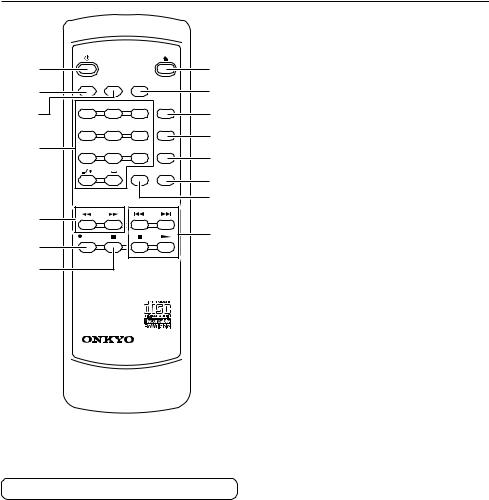
Part names and functions |
|
||||
|
|
|
|
|
Alphabetic letters/Symbols/Numeric/(1 to |
|
|
|
|
|
10) buttons [30] |
|
STANDBY/ ON |
OPEN / CLOSE |
Press to enter a disc name, track titles, and an |
||
1 |
|
|
|
8 |
artist name. |
|
|
|
5 d/f(rewind/fast forward) buttons |
||
2 |
RANDOM MEMORY |
REPEAT |
9 |
||
|
|
|
[30, 38] |
||
3 |
|
ABC |
DEF |
NAME |
Press to rewind or fast forward through the |
1 |
2 |
3 |
10 |
track currently playing. Press to move the cursor |
|
|
GHI |
JKL |
MNO |
SCROLL |
|
|
forward or backward when changing the name |
||||
4 |
4 |
5 |
6 |
11 |
|
PQRS |
TUV |
WXYZ |
CLEAR |
of a disc. |
|
|
7 |
8 |
9 |
12 |
6 oREC (recording) button [20, 22, 25] |
|
|
||||
|
|
|
DISPLAY |
ENTER |
|
|
|
|
For analog and digital recording, press to place |
||
|
>10 |
10/0 |
|
13 |
|
|
|
|
|
14 |
the DX-R700 in the recording standby state. |
|
|
|
|
7 g(pause) button [38] |
|
5 |
|
|
|
|
|
|
|
|
15 |
Press during playback to pause the playback. |
|
|
REC |
|
|
Press the sbutton to resume playback. |
|
6 |
8 r(tray open/close) button [17] |
7 |
Press to open and close the disc tray. |
REMOTE CONTROLLER |
RC-448C |
The numbers within the brackets are the pages where the part is introduced.
RC-448C remote controller
1STANDBY/ON button [16]
While the POWER switch at the DX-R700 is pressed in, press to switch the DX-R700 between the on state and the standby state.
2RANDOM (random playback) button [39]
Press to playback the tracks on the disc in random order.
3MEMORY (programmed playback) button [40]
Press to program the tracks to play in memory.
4Numeric buttons [30, 40]
Press the number for a track to start playback at that track. Also, press to program tracks for programmed playback.
9REPEAT (repeat playback) button [39]
Press to repeat the playback of a disc or a track.
10NAME button [28, 31, 32]
Press to begin entering a disc name, artist name, or track titles. Also press this button to confirm the name you input.
11SCROLL button
Press to scroll a displayed disc name, artist name, or track titles.
12CLEAR button [30]
Press to erase the programmed tracks one at a time from the end. This button is also used to erase the character entered.
13ENTER button [30]
Press to enter and confirm a disc name, artist name, or track titles.
14DISPLAY button [27-29]
Press to change the contents of the display.
15OPERATION button e(stop) button [38]
Press to stop recording or playback. s(play) button [38]
Press to start analog recording, digital recording, and playback.
q/w(skip) buttons [30, 38]
Use to jump to tracks prior to or later than the one currently playing. Use while playback is stopped to select the track to play.
10

Using the remote controller
■Using the RC-448C remote controller
Installing the remote controller batteries
1Push the battery cover in the direction of the arrows shown and remove it.
2Install the supplied (or AA, R06, or UM-3-sized) batteries into the battery compartment being careful not to mistake the polarity (follow the polarity diagram inside).
3 Replace the battery cover.
Notes:
•Do not mix new batteries with old batteries or different kinds of batteries.
•To avoid corrosion, remove the batteries if the remote controller will not be used for a long time.
•Immediately remove dead batteries to avoid damage to the remote controller from corrosion. If the remote controller begins to operate improperly, remove the old batteries and replace them with two new batteries.
•The life of the supplied batteries is approx. 1 year, though this value may vary depending on usage.
Using the remote controller
When operating the remote controller, point it toward the remote control sensor of the DX-R700.
Remote control
DX-R700 sensor
30° 
30°
5m
Notes:
•If the remote control sensor is subjected to direct sunlight or inverted fluorescent light, operation of the remote controller may be adversely affected.
•Use of another remote controller nearby or using the remote controller near equipment that uses infrared light may cause operational interference.
•Do not put objects on the remote controller. A button on the remote controller may remain pressed and drain the batteries.
•Make sure the DX-R700 is not placed behind colored glass doors. Placing the DX-R700 behind such doors may prevent proper operation of the remote controller.
•If there is an obstacle between the remote controller and the remote control sensor, the remote controller will not operate.
11
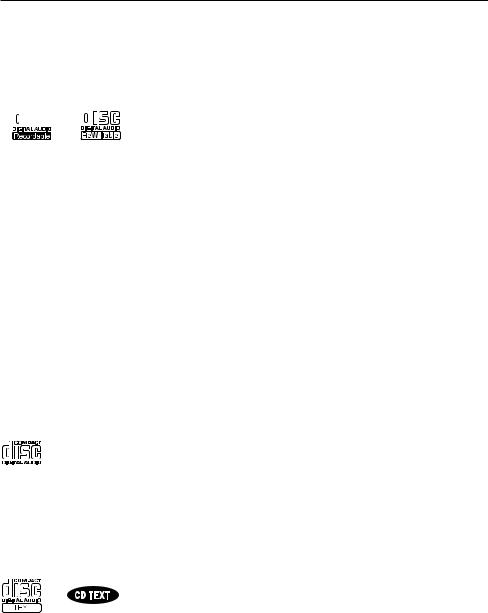
Notes on usable CDs
Notes on usable discs
•CD-Recordable (CD-R) and CD-ReWritable (CD-RW) discs
When recording with the DX-R700, you must use compact discs with the following marks printing on them:


 *1
*1 


 *2
*2
FOR CONSUMER FOR CONSUMER USE
FOR MUSIC USE ONLY
(A disc with any of the above markings.) Recording cannot be performed on discs that do not have one of the above markings.
Copyright fees have been enacted by copyright laws, and these fees are included in the price of CD-R*1 and CD-RW*2 discs, as well as discs labeled with
“FOR CONSUMER,” “FOR CONSUMER USE,” and
“FOR MUSIC USE ONLY.” Therefore, the recording
of music protected by copyright laws with these
discs is permitted for personal use. However, copying
for purposes other than personal use requires the
permission of the copyright holder.
• Compact discs
Always use compact discs with the following mark (optical digital audio discs):
CD TEXT
CD TEXT is a feature added to audio CDs that provides the ability to deliver text information (alphabetic letters, symbols, and numbers) such as disc titles, artist names, track titles, etc. Commercial audio CDs that contain this text information bear the following mark.
Cautions regarding copyrights
The lyrics and melodies composing the musical elements of media and musical performances from radio broadcasts, compact discs, records, music tapes, original cassettes, and other media are protected equally by copyright law. Therefore, the sale, transition, distribution, and re-release in mediaform, or use as background music in stores and the like, is strictly forbidden without the previous express consent from the copyright holder.
CD-R finalization process
After recording onto a CD-R disc, it is necessary to perform the finalization process before the CD-R can be played in CD players. After the finalization process is completed, you cannot perform additional recordings.
CD-ReWritable (CD-RW) discs
CD-RW discs cannot be played in normal CD players even after finalization. CD-RW discs can only be played on players compatible with CD-RW discs. Also, with CD-RW discs, recording can be erased even after finalization.
12
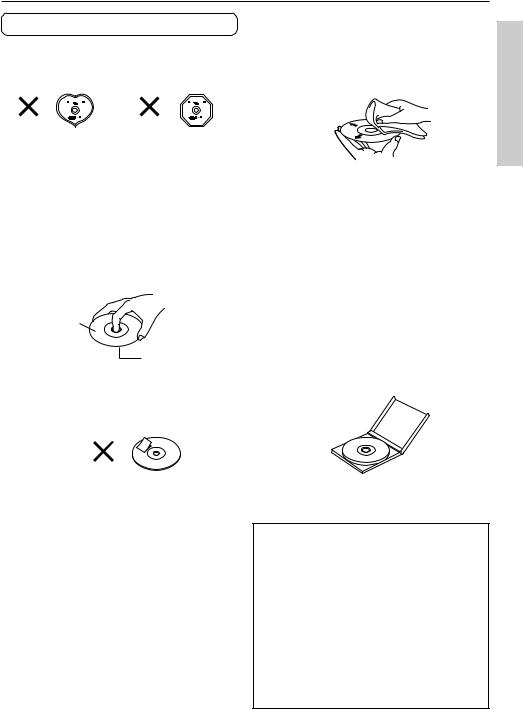
Notes on usable CDs
Notes on discs
Never use heart-shaped, octagonal, or other special shaped discs as they may damage the internal mechanisms of the DX-R700.
Do not play CD-ROMs intended for computer use or non-audio compact discs. Doing so may cause highpitched noises or other unpredictable results that may damage speakers, amplifiers, and other connected components.
■ Handling discs
Be careful not to touch the data side of the disc (the side that does not have printing on it). Always hold discs by the edges or by using the hole in the middle.
Label side
Data side
Never place labels or stickers on the data side or label side of the discs. Also, do not write on the discs or allow them to become scratched.
■Cautions when using rented compact discs
Do not use discs that have cellophane tape attached to them or rental compact discs that have rental labels attached. If the tape is sticking out or peeling off, the disc may not be able to be ejected and the DX-R700 may become damaged.
■ Do not use 8-cm CD adapters
■ Cleaning
Dirt and contaminants on discs can obstruct the pickup of the signals and lead to deterioration the sound. When dirty, clean the data side with a soft dry cloth, wiping from the inside of the disc toward the outside.
If the dirt is excessive, soak the cloth in water, wring it out, and then wipe the disc surface clean. Next, using a soft dry cloth, wipe the moisture from the disc surface.
Do not use conventional record cleaners or antistatic agents. Also, never use benzene, thinners, or other volatile agents as they may damage the disc surface.
■ Cautions for disc storage
Do not store discs in locations exposed to direct sunlight, near heat emitting devices, and other locations of excessive heat, or locations of extremely low temperatures. Also, always store discs properly in their protective cases.
Condensation
When moving the DX-R700 from a cold location
to a hot location, when quickly heating a cold
location with a furnace, or other similar situation,
condensation may occur. This may not only cause
improper operation of the device, but may also
damage the discs and components.
If condensation has occurred, turn on the DX-
R700 and leave it running for 1 to 2 hours. If you
will not use the DX-R700, then eject any disc
inside.
13
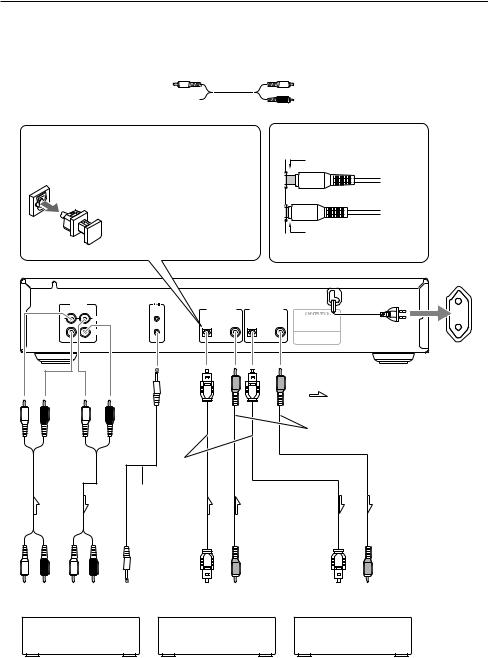
Connections
Connecting the DX-R700
■ Connecting to other components
The DX-R700 contains components that are extremely heat sensitive, so do not place the DXR700 on the amplifier.
Always complete all connections before inserting the power cord into the wall outlet.
To L channel of the DX-R700 (White) 
To R channel of the DX-R700 (Red) 
Protection cap for the optical digital input terminal
When necessary, remove this protection cap and store it safely. When not using the optical digital input terminal, be sure to put the cap back on the terminal.
ANALOG |
|
|
|
|
|
|
|
INPUT |
OUTPUT |
REMOTE |
|
DIGITAL INPUT |
DIGITAL OUTPUT |
||
(REC) |
(PLAY) |
CONTROL |
1 |
|
2 |
|
|
|
|
|
|
|
|
||
L |
L |
|
OPTICAL |
COAXIAL |
OPTICAL |
COAXIAL |
|
R 

 R
R
(White) To L channel of other component (Red) To R channel of other component
Improper connection
Insert completely
5
AUDIO CD RECORDER
MODEL NO. DX-R700
Wall outlet
L |
R |
L |
R |
|
: Signal flow |
|
|
||||
|
|
|
|
|
Coaxial cable |
|
|
|
|
|
(not included) |
|
|
Analog |
|
Optical |
Digital output |
|
|
output |
|
digital |
|
Analog |
|
|
|
||
|
|
|
cable |
|
|
input |
|
|
z |
|
|
|
|
|
|
||
|
|
|
cable |
Digital input |
|
|
|
|
|
||
|
|
|
|
(1 or 2) |
|
1 |
|
|
2 |
3 |
4 |
L |
R |
L |
R |
|
|
Analog |
|
Analog |
z |
Digital output |
Digital input |
output |
|
input |
connector |
|
|
|
|
Amplifier |
|
CD player, |
MD recorder, |
|
|
|
DAT deck, etc. |
CD recorder, etc. |
|
|
|
|
|
||
14

Connecting the DX-R700
1 Connecting to an amplifier
Connect the DX-R700 to the CDR, TAPE or MD terminal on the amplifier.
•Connect the red connectors of the supplied audio connection cables to the R-channel terminals and the white connectors to the L-channel terminals.
•Make sure the connectors are properly inserted all the way. If the connectors are not properly connected, noise or improper operation may result.
•Do not bundle the audio cables together with power cords or speaker cables. Doing so may cause deterioration of the audio signal.
2 Connecting the zcable
•With Onkyo components that are equipped with an zconnector, use the supplied zcable to connect the zconnector to the zconnector of the DX-R700.
•The zconnectors are only effective if they are used in conjunction with an Onkyo amplifier with an z connector. Do not connect to a component other than an Onkyo component with an zconnector. Doing so may damage the DX-R700.
•The function of the upper and lower zconnectors are the same. Connect to either one.
•Connecting the zcable only does not make the system operational. You must also connect the audio cables as well.
3 Connecting to the digital input
Using the digital input, you can record digital audio from compact disc players, DAT decks, and other digital audio components that have a digital output. Connect using the supplied optical digital cable and either the DIGITAL INPUT 1 or 2 input on the DX-R700. You can also connect to amplifiers that are equipped with digital output terminals.
Notes:
•The optical digital terminal is provided with a protection cap installed. When necessary, remove this protection cap and store it safely. When not using the optical digital input terminal, be sure to put the cap back on the terminal.
•To perform digital input recording, you must connect to the optical digital input terminal. If the digital connection is not made, “D.In Unlock” will appear in the display.
4 Connecting to the digital output
Using the digital output, you can connect to MD recorders, CD recorders, DAT deck recorders, and other digital audio recorders that have optical digital input connectors for making digital recordings. You can also connect to amplifiers that are equipped with digital input terminals.
5 Connecting the power cord
Plug the power cord into an AC wall outlet.
15
